Nymphing For Steelhead: The 3 Most Effective Methods
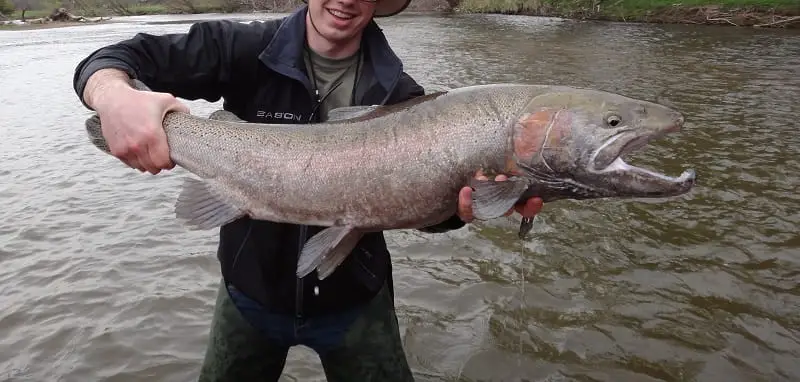
I have been teaching fly fishermen how to effectively nymph for steelhead for over twenty years now. As an expert at this method, I can easily say that nymphing is the most effective way to catch steelhead with a fly rod, but only if you do it properly.
I use methods that I’ve learned from veteran guides and from some of the world’s best competition anglers. There are three effective ways to nymph for steelhead, and I will explain them here.
Nymphing for steelhead is when you present your fly below the surface in a way that naturally imitates the steelhead’s natural food sources (1).
The three most effective ways to do this are:
- Indicator Nymphing: This method uses a bobber-like device known as a strike indicator that helps detect bites. Good anglers will also utilize the indicator to present the fly better, which in turn means more hook-ups.
- Suspension Nymphing: This method is similar to Indicator nymphing except with a shorter leader, which enables the indicator to suspend the fly off the bottom. This can be superior and allows the angler to get a better presentation and bite detection.
- Euro Nymphing: This is a tight-line competition method that was initially designed for trout fishing. However, in certain situations, it is the most effective way to catch steelhead.
What To Consider If You Want To Nymph Well
- Using these methods properly with the proper leader setup and the proper presentation is critical. Based on my experience after teaching thousands of anglers how to nymph for steelhead, most anglers do not nymph very well.
- I will use different nymphing methods at different times and under different types of river conditions. It’s important that you understand when to use each method if you want to maximize your success.
- The best flies to use when steelhead nymphing would be imitations of aquatic insects, fish eggs, or worms. However, even a great fly is nearly useless if you don’t present them properly.
- Nymph fishing for steelhead is often the most effective way to fly fish for steelhead on mid-sized rivers that are 120 feet wide or smaller. Rivers or creeks from 10 to 50 feet wide are my favorite for nymphing.
- Long fly rods of ten to eleven feet are best for nymphing.
Choosing The Right Nymphin Method
The method of nymphing that I use when fishing or guiding for steelhead will depend on a few factors, such as:
- Size of the spot I’m fishing.
- The distance that I need to cast to get the fly to the fish while being able to present the fly properly.
- The depth of the spot.
- The speed of the spot that I want to fish.
Anglers that know when to change their nymphing method based on the conditions in front of them will be able to catch a lot more steelhead. I will discuss each method and when to use them below.
Best Steelhead Fly Rod And Reel
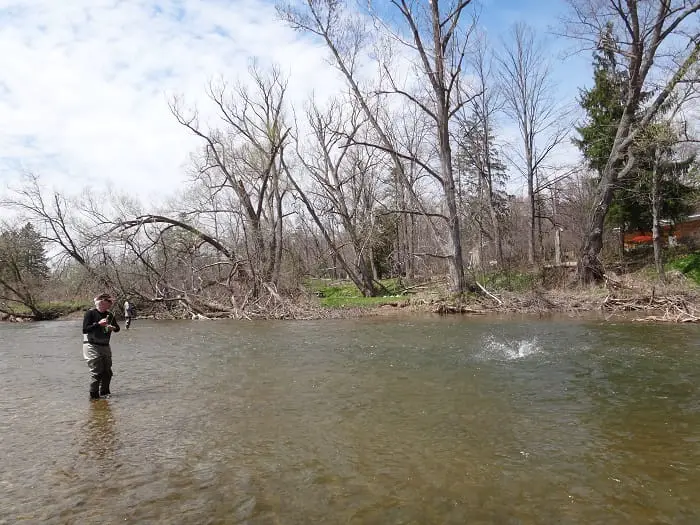
The best steelhead fly rods for nymph fishing are the longer 10 to 11 foot fly rods in the 7 or 8 weight size. Match your fly rod with a suitably sized fly reel that has a large arbor spool and an enclosed drag system that is also smooth, and you’ve got the perfect setup for nymphing.
The best rod that I recommend to all my clients for steelhead nymphing around the Great Lakes region is a 10 foot 7 weight fly rod. For the Pacific West Coast steelhead consider an eight-weight, or try a nine-weight for large rivers.
The longer fly rods allow you to cast further, allows you to control your line and indicator better, allows you to mend your lines easier and better, and the longer rod acts like a big shock absorber that can protect lighter tippets.
My experience with switch rods is that they are a decent option for guys that primarily want to nymph fish for steelhead on large rivers with a longer rod. They do flip over indicators and leaders full of weight more easily, but I also find them to be heavy and not necessary on rivers that are less than 60 feet wide. I’d much rather fish a lighter 10 foot single hand rod all day than a big heavy swithc rod.
See this link if you are in search of the best steelhead fly rods.
Best Steelhead Nymphing Fly Lines
You could use just about any general-purpose fly line when you nymph fish for steelhead as long as it matches the rod and reel.
There are some better steelhead lines that will make casting indicator rigs with weights and bigger flies much easier. These lines also help with mending.
Mending gives you better drifts, better line control, better mends, and that all equals more steelhead.
The best steelhead nymph lines often have shorter aggressive heads and long back tapers that help anglers turn over heavy nymphing rigs, especially when fishing on bigger rivers that require further casts to get your flies out to the fish.
I recommend these nymphing lines for anglers fishing for steelhead around the Great Lakes and on the West Coast.
For most indicator fishing on small to mid-sized rivers, the RIO Intouch Salmo/Steelhead Fly Line is an excellent choice. On bigger rivers, like the ones that you would find out west, one of the best lines is the Scientific Anglers Amplitude Anadro Fly Line.
Indicator Fishing For Steelhead
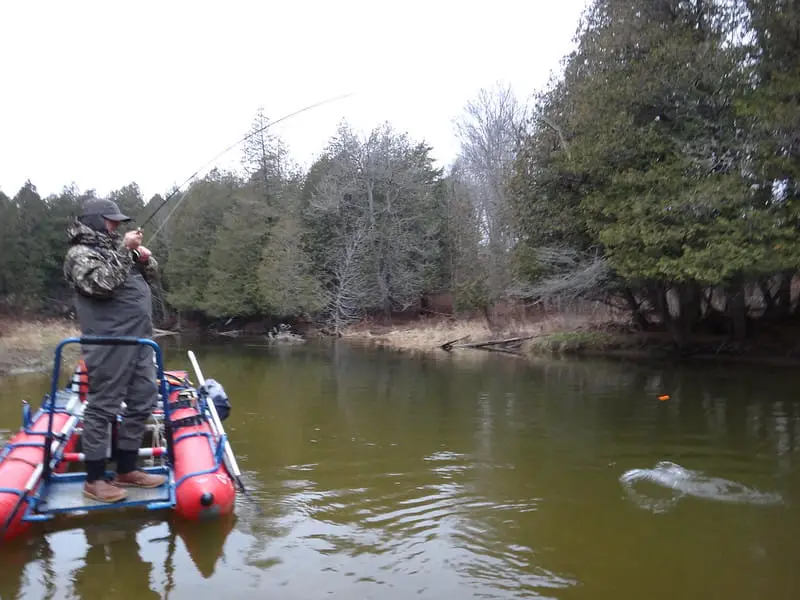
Indicator nymphing is often used by most guides simply because it’s easy to teach and easiest to use while still being effective in certain types of water. But easy doesn’t mean best or most effective.
Indicator fishing for steelhead means that you are presenting your fly either by dragging it along the bottom below an indicator or by suspending your fly below an indicator.
I prefer to not use the old school method of dragging my fly under an indicator anymore because I believe it is less productive and comes with some unwanted problems that limit how many fish you will catch. I explain this in the extended nymphing article.
I prefer to use a method known as suspension nymphing, which is when you suspend your fly up and off the bottom with the use of a floating indicator and just enough weights or a weighted fly to get your fly down into the strike zone.
Using the suspension nymphing method for steelhead allows anglers to control their baits spee and their leader angle, which allows for a better presentation, equaling more bites. Suspension nymphing also allows you to detect all those extra bites much better.
There are two ways to hold your indicator back to control your bait speed, and to manage your indicator angles when suspension nymphing. I discuss this in my extended version of this nymphing article.
Old School Indicator Method
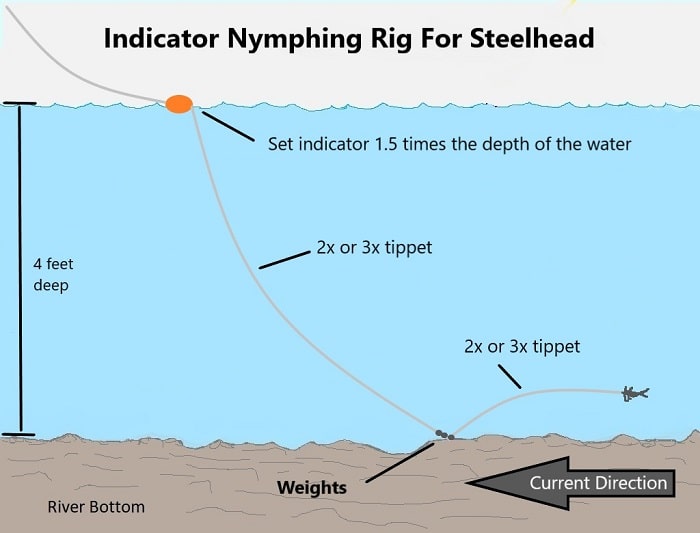
You may have heard people and even guides tell you that you want to set your indicator at one and a half times the depth of the water that you are fishing. I’ve even heard people say two times the depth of the water that you are fishing.
That means if the spot you are fishing is 4 feet deep, you want your leader below your indicator to be at least 6 feet deep
This long leader sometimes works, but it’s an old method that needs to be revised. I rarely use it because it causes more snags and limits strike detections due to the increased occurrence of slack in the leader.
Only experts know about this method, which is why you will still see most fly anglers fishing this way.
If there is slack in the line anywhere between your fly and your indicator, the indicator will not go under until that slack is removed, and often, by that time, the steelhead will have already spit the fly out.
Pro Tip: Guys, almost always, if your indicator is moving at the same speed as the bubbles or the same speed as the surface current, you ARE DRAGGING your flies. This can and will prevent some fish from grabbing your fly. I guarantee this!!
There is a better way to use an indicator.
Suspension Nymph Fishing For Steelhead: The Better Way
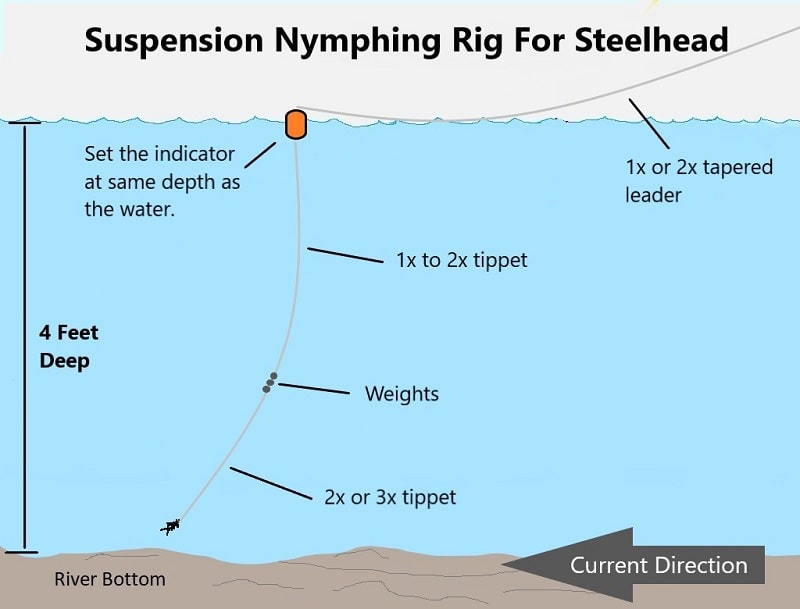
Using the suspension nymphing method is one of the best ways to control the speed of your flies while taking the drag out of the presentation and improving your strike detection.
With suspension nymphing, you set your indicator at the depth of the water that you are fishing. Your fly and weights should not be dragging the bottom. Ideally, you want your fly 6 to 12 inches off the bottom at all times.
Doing so keeps everything up and off the bottom and in the strike zone where the fish are feeding. You are basically suspending everything from the floating indicator.
There is no weight being dragged across the bottom and there is no slack in the setup to prevent you from missing bites so now you can focus on mending your line to slow your indicator and your fly down.
2 Fly Suspension Nymphing Rig For Steelhead
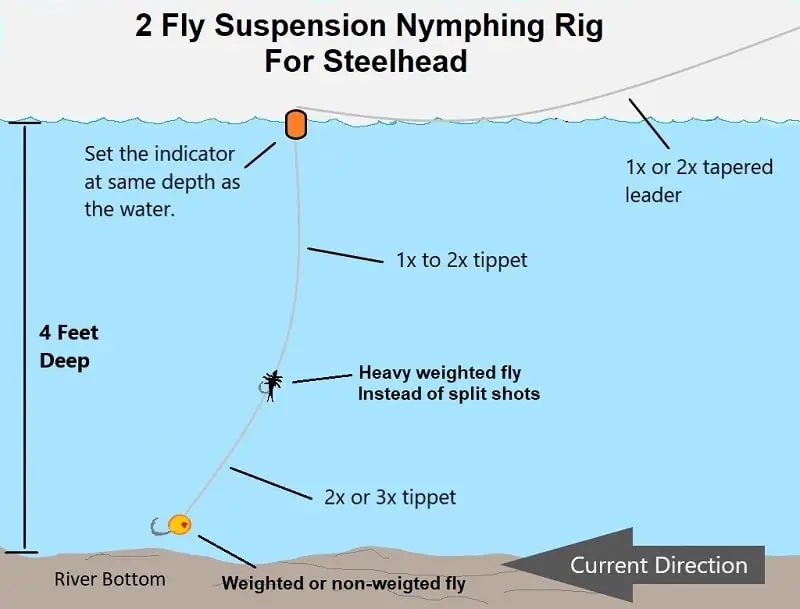
You can also use the suspension nymphing rig with two flies and no weights. (only use two flies where permitted by law) I actually use this two fly system more than the two fly rig above with the weights.
The idea is you are suspending both flies off the bottom as much as possible without them touching or dragging the bottom.
If possible, I want my bottom fly to be 6 to 12 inches suspended off the bottom at all times, and my top fly higher, but only high enough that the fish can also see it. I discuss how high below.
So in 4 feet of water, your entire leader length should be 3.5 feet to 4 feet long.
The type of flies that you use on the top or the bottom of this setup is up to you, however, when I do this at least one fly is weighted to keep both flies down and in the strike zone.
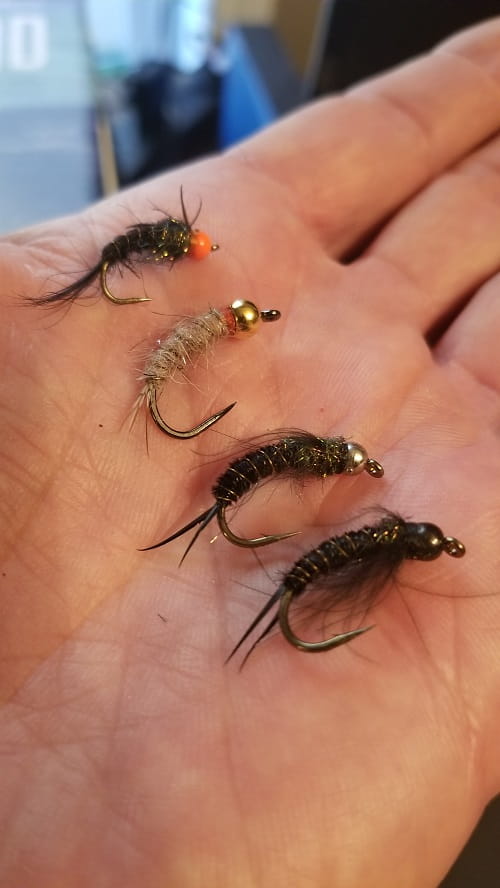
NOTE: If you do not have weighted flies, get some, or just use split shots. If you have to use weights, use one or two split shots 6 to 12 inches above the top fly and maybe a second single weight situated dead center between the two flies.
Ideally, it’s best NOT to use weights and only to use weighted flies.
The distance between the two flies will depend on the conditions. The dirtier the water the closer I want those two flies because I want to be sure the fish sees them both.
And, often, in dirty water, they will hold tight to the bottom. So if the water is 12 to 14 inches of visibility, I will have my flies 6 to 14 inches apart.
You can see this dropper tag set up on my page 2-Fly Nymphing Rigs.
Basic Steelhead Leader Formula For Nymphing With An Indicator
My leader formula consists of the following items:
- Indicator
- 0X to 3X tapered Leader
- 1X to 3X tippet
- Tippet rings and micro swivels
- Split shots
- Flies
Steelhead Indicator Rig Diagram
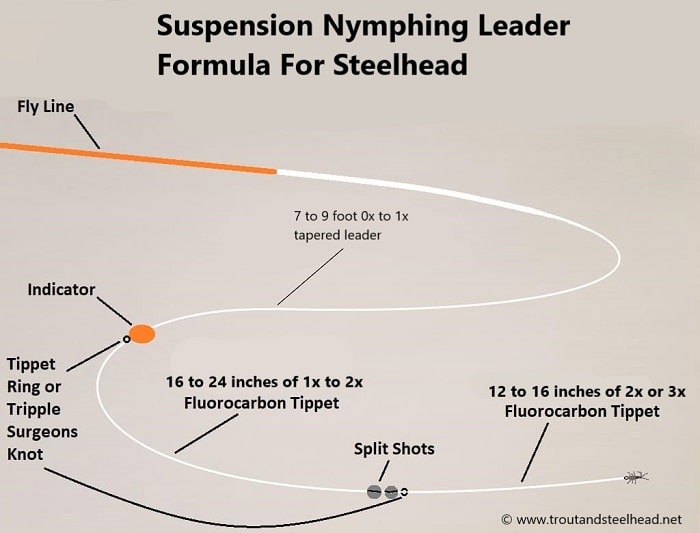
Best Indicator For Steelhead Fishing
The indicator that you use for these steelhead nymphing methods makes a difference. There are a bunch of indicators on the market and most are crap.
A good strike indicator will help you control your speed, improve your leader angles, help you know where your fly is during the drift and it will help improve your strike detection.
If you want to catch more fish all of these things are important. You can see my favorite indicators on my page What Are The Best Indicators For Fly Fishing? Guides Advice.
Euro Nymph Fishing For Steelhead
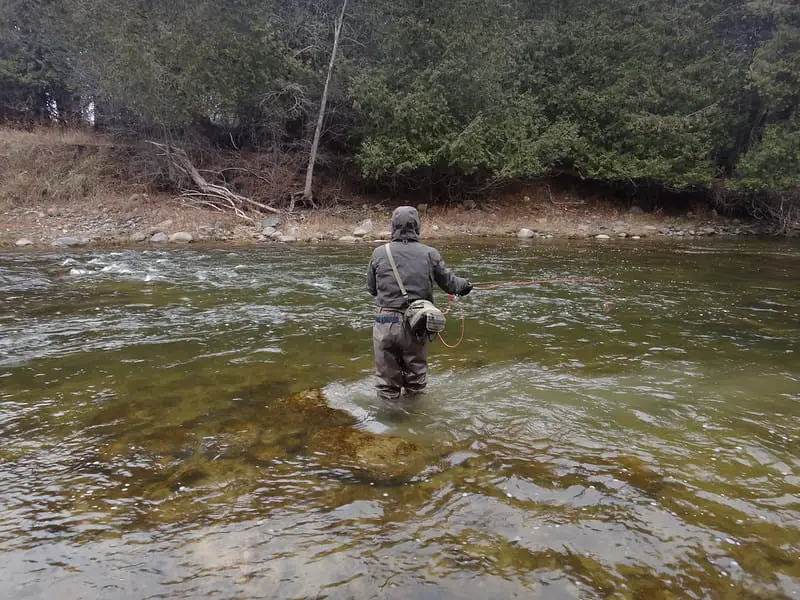
Euro Nymphing or as some anglers call it, “tight line nymphing” or “modern nymphing”, can be the most effective method for steelhead in shallower water, pockets, riffles, and smaller pools.
Euro nymphing excels in shallower water under 5 feet deep with medium to fast currents.
Euro nymph fishing enables you to slow your flies down to get a more natural drift and it can’t be beaten for strike detection. Both of these things mean more steelhead in the net.
I go over everything you need to know about this very productive method on my page Euro Nymph Fishing For Steelhead.
Best Steelhead Flies
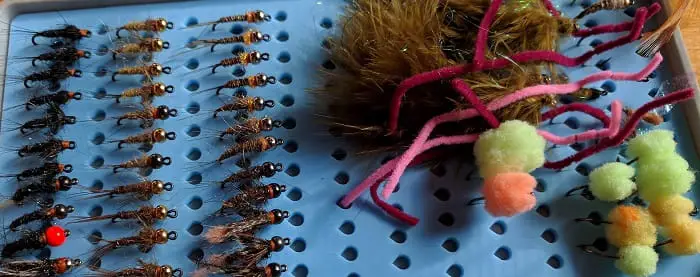
The flies that you use are an important part of steelhead nymphing. I discuss my best steelhead nymphs on my page Best Flies For Steelhead.
You have just read the shortened and rvised version. If you would like more information that is more detailed, check out the FULL VERSION.
If you have a question, comment, or a tip about nymphing for steelhead let me know in the comments section below.
Tight Lines
Graham

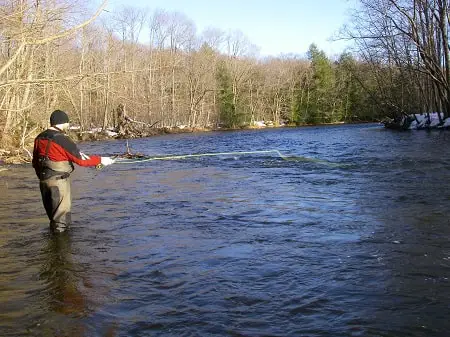
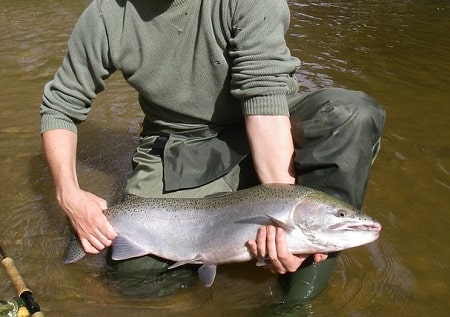
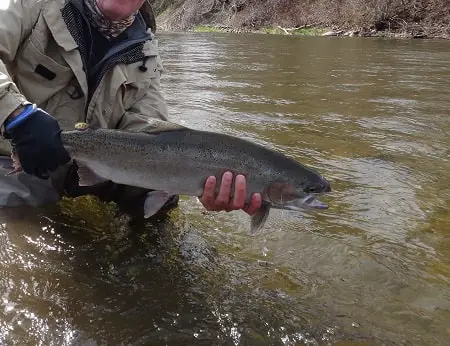
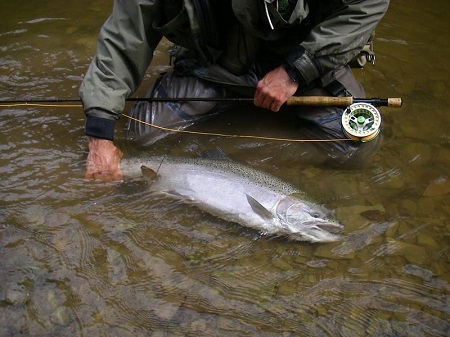
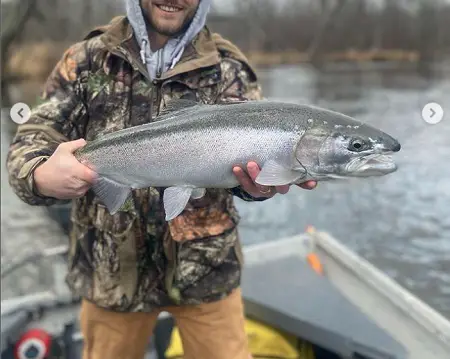
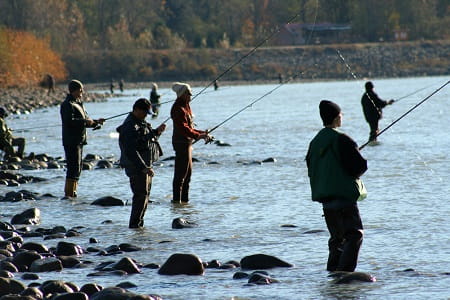
Great article Graham. When using the suspension indicator set-up, do you space out your split shot on the similar to what the centerpin anglers do or do you concentrate the split shot together by the swivel?
Hi Chuck,
I usually concentrate the split shots, however, I don’t see why spacing out the split shots wouldn’t work to.
I fish the great lakes tribs, specifically Northwest PA. My favorite water is riffle/small pocket water, usually less than 3 feet in depth. I’m guessing that you would euro nymph such water. Would/Could you even consider suspension nymphing such shallow water? I’m a slave to the strike indicator but am always weary of having the indicator too close to the fly. I know that my drift is awful because the indicator is too high and the water is too shallow so the bait is dragging. Would you ever put the indicator < 2 feet from the fly? Thanks
Hi Jay,
You could fish an indicator in a foot of water if you really wanted to, however, it’s not ideal. If you must use an indicator, when fishing in very shallow water consider trying it with an indicator like a white New Zealand Yarn indicator so it doesn’t spook the fish. I also used to use white Thingamabobbers or better is the white Air-Lock Strike Indicators because they look like bubbles and they don’t spook the fish. You will still have some drag on the fly which could limit your hookups but it’s better than a big intrusive Orange indicator.
I would also try using weighted flies instead of adding weights on the line so you are not dragging weights over their heads.
I was a slave to the indicator as well and hated Euro nymphing at first. I would try it and then go back to my indicator, then try it again and again and again, but liked my indicator, however with practice I got very good at Euro Nymphing and I soon realized that it is just as easy and much more effective especially in the type of water that you fish in.
Hope that helps and good luck.
Thanks for the info been fly fishing 10 years and still learning i dont catch alot but this will help Thanks again.
Hi Miles, one of the fun things about fly fishing is the learning process.
I’ve been very lucky to have had great teachers and to be able to be on the water with thousands of anglers which has helped me narrow down what works and what doesn’t. I will be sharing that info on the hundreds of new pages I will be adding to this website later this year. That should help you catch more fish.
Hey Graham, I see that your favorite indicator for a fly rod is the raven float. How would you rig that for a fly rod? Would it be similar to your centerpin set up? (indicator,swivel, 20in shot line, swivel, 16in line, fly). Also, how would you do a 2-bait suspension rig with a raven float? Thanks in advance! I discovered your page a week ago and I have learned so much! My confidence and success on the river has already increased because of this page and I am incredibly grateful. Thanks again.
Hi Mike,
I’m glad you like the page.
See the diagram for the suspension nymph rig. That is usually how I set it up with or without the Raven float. To do 2 fly setup I usually run a short 6 to 10-inch tippet from the knot or the tippet rig at the weights and then a second fly would be an additional 10 to 14 inches below that.
Graham
Hi Graham,
When you talk about Suspension nymphing, how do anglers fly fishing angle their float torwards themselves like centerpin fisherman are able to do?
Hey Hunter,
Good question, it’s a bit hard to explain so I hoping to do some video tutorials this spring.
There are two ways to hold your float back and manage your indicator angles when suspension nymphing. The first way is to use the high stick(high rod tip) method with no line on the water and then control the speed of your float by moving your rod tip downriver at the desired speed, it usually only takes a little bit of hold to slow the indicator and change the angle.
The other method is to stack mend or shoot mend the line directly above your indicator. With all the fly line directly upriver of your indicator, it will create line drag which holds back the indicator. If the indicator starts to move too fast, slowly pulling the line upriver will slow it down again. Done right and you can make long drifts with some speed control.
Great article. Im thinking about getting an 11; 7 wt switch rod and will be primarily mymphing for steelhead. Do I get a traditional 7 wt line or a skagit head or scald head?
Hey Alan,
Sorry for the delay, your message ended up in a spam folder.
If you are only nymphing, I would use a standard weight-forward line. You can also cast that if you want to swing flies or strip streamers.
If you think you might want to swing flies using Spey casts occasionally, there are some good switch rod lines on the market that are designed for both nymph and spey casts.
If you don’t ever plan to spey cast, stick to a regular fly line and forget about scandi and skagits lines, those lines are made to cast, not to nymph.
Hope that helps and good luck,
Graham
starting euro nymphing. your article has been very helpful. fishing small/medium michigan rivers for steelhead. have the cortland 7 wt. have appropriate reel. now need proper euro line. when researching, some say euro set-up can be used for dry fly applications. a little confusing to me. can you recommend appropriate euro line for above situations? thanks.
Hey Joe,
This is what I recommend to my good clients. Just use any standard weight forward fly line that matches your rod weight. The reason I say this is because if you use the very productive French or Spanish nymphing method, I use the Spanish method, you almost never use your fly line while fishing anyways. Therefore the fly line is irrelevant, and since it’s a standard weight forward line you can easily switch and use it for indicator or streamer fishing if you want to change methods without changing reels.
I have fished with some very good competition euro anglers, including a world champion fly angler, and a multi-medal competition angler, and they rarely if ever use their fly lines when nymphing, and neither do I.
Instead, I’v3e updated the article and included info on the Long leader and Long OPST leader.
One of the problems with Euro Lines is they are not made for steelhead and 7 weight rods, therefore you will need to use a 5 weight, they can be 12 to 15 pound break strength so be careful applying to much pressure.
Also, I would not recommend dry fly fishing with Euro lines, however, a good caster could probably do it.
Graham
I just started fly fishing this fall and have done alright. My question with the suspension fishing vs having a 1.5x leader length. Its hard to tell the depth at times so the extra leader length provides some cushion. How do you you know your fishing the right depth? I typically add weight or lower raise indicator till I know its ticking bottom with the method Im using.
Thanks for the awesome page. Just found it today
Hi Aaron,
Should there be a depth increase the 1.5x leader will be good as it will ensure your fly gets deep enough in that case. With a suspended leader there is a chance you will be too high should it get deeper, but, hopefully, the trout will rise up, and since they feed up it’s probable. I personally believe it’s better to be too high than it is to have the fly dragging the bottom or have the fly too far in front of the indicator to detect a bite, which both thing are more likely to happen with 1.5x depth.
As you mentioned, for both methods, you will watch your indicator to see if it ticking bottom. With the 1.5x depth you will leave it at the depth if it only ticks the bottom periodically, but, with the suspension method, you should make it 6 to 12 inches shallower so you are mostly suspended.
Hope that all makes sense.
Graham
I’m learning so much from your website. Thanks for sharing you knowledge. So far, I only have 3 days of steelhead nymph fishing under my belt (several years with trout).
With a 2 fly suspension nymphing rig like the one diagrammed in your article, with the weighted fly at top, and an unweighted egg as the bottom fly, it seams like the egg would not get to the bottom, below the weighted fly. Should the tippet length to the top fly, below the indicator, be set to river depth so that the weighted/top fly is drifting on or near the bottom, then dragging the egg along with it? Please explain.
Hi Darin,
I’m happy to hear you are enjoying the site.
If just added a bunch to that section that might make it a lot more clear so go check it out.
In short, you never want your fly dragging the bottom. You want both flies suspended off the bottom. You will catch more fish with your bottom fly 12 inches over thier heads then 1 inch below their heads. Trout and steelhead tend to feed forwards and up, and rarely down.
So in 4 feet of water, your entire leader length should be 3.5 feet to 4 feet.
Hope that helps
Graham
Great article, very comprehensive.
I’m an old school nympher from way back but haven’t fished a lot recently. Getting back into it now I tried the old method with no success. I’ve researched the suspension method and have been trying to master that rig. Your article has helped me understand this method along with the euro nymph method.
Very well done . Thanks!